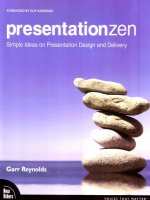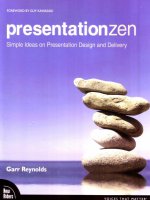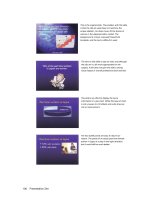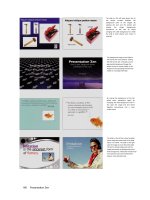Presentation minerals and rocks
Bạn đang xem bản rút gọn của tài liệu. Xem và tải ngay bản đầy đủ của tài liệu tại đây (12.34 MB, 67 trang )
Suez University
Faculty of Petroleum & Mining Engineering
Minerals and Rocks
Student
Belal Farouk El-saied Ibrahim
Class / III
Section / Engineering Geology and Geophysics
The Reference / Basic Pet. Geology
)P.K.Link(
Presented to
Prof. Dr. / Shouhdi E. Shalaby
Main Topics
Main Topics
Minerals.
Minerals.
Rocks.
Rocks.
Igneous
Igneous
Sedimentary
Sedimentary
Metamorphic
Metamorphic
Rock cycle.
Rock cycle.
What are minerals?
What are minerals?
All rocks are composed of
All rocks are composed of
minerals
minerals
Minerals are naturally
Minerals are naturally
occurring, inorganic,
occurring, inorganic,
crystalline solid with a
crystalline solid with a
definite chemical
definite chemical
composition found on
composition found on
Earth.
Earth.
There are about 3500
There are about 3500
known minerals
known minerals
About 20 minerals make up more than 95%
About 20 minerals make up more than 95%
of all of the
of all of the
rocks
rocks
in the Earth
in the Earth
’s crust
’s crust
Composition of the Earth’s Crust
Composition of the Earth’s Crust
Eight Elements that make up over 98%
Eight Elements that make up over 98%
of Earth’s Crust
of Earth’s Crust
-Oxygen (O)
-Oxygen (O)
-Silicon (SI)
-Silicon (SI)
-Aluminum (Al)
-Aluminum (Al)
-Iron (Fe)
-Iron (Fe)
-Calcium (Ca)
-Calcium (Ca)
-Sodium (Na)
-Sodium (Na)
-Potassium (K)
-Potassium (K)
-Magnesium (Mg)
-Magnesium (Mg)
MINERAL PROPERTIES
Physical properties of minerals are dictated by the
nature of the underlying atomic structure, nature and
arrangement of chemical bonds, and energy levels of
valence electrons.
Color
Color
Luster
Luster
Hardness
Hardness
Streak
Streak
Density
Density
Crystal Shape
Crystal Shape
Cleavage and Fracture
Cleavage and Fracture
Special Properties
Special Properties
Color
Color
Usually the first and most easily observed
Usually the first and most easily observed
-Some minerals are always the same color
-Some minerals are always the same color
-Some minerals can have many colors
-Some minerals can have many colors
QUARTZROSE QUARTZ SMOKY QUARTZ
Luster
General
General
appearance of a
appearance of a
mineral surface in
mineral surface in
reflected light
reflected light
Glassy-Obsidian
Hardness
External Crystal Form:a solid plane in which the
atoms are arranged in orderly, repeating patterns
A. cubic
B. tetragonal
C. hexagonal
D. orthorhombic
E. triclinic
F. monoclini
(some minerals do not show well-developed crystals).
Fluorite
CUBIC
HALITE
TETRAGONAL
WULFENITE
HEXAGONAL
BERYL
ORTHORHOMBIC
TANZANITE
MONOCLINIC
GYPSUM
TRICLINIC
MONTEBRASITE
CLEAVAGE: splitting along preferred directions due to weak
bonds within the atomic structure. Cleavage is described as perfect,
good, poor.
This is a property of crystals – be careful that you are
looking at crystals and not crystal aggregates.
Cleavages can be confused with crystal faces – can often see
cleavage planes perpendicular to crystal faces.
Some crystals do not show cleavage due to similar bond strengths
throughout the crystal structure. However, a crystal can have 1, 2,
3… directions of cleavage. It is important to note: (i) the number
of cleavage directions, and (ii) their angular relationship:
1 direction; 2 directions at 90 ; 2 directions, inclined; ˚
3 directions, cubic; 3 directions, rhombohedral;
4 directions, octahedral; 6 directions dodecahedral.
Planer Cleavage in Mica
Planer Cleavage in Mica
Rhombohedral Cleavage in Calcite
Rhombohedral Cleavage in Calcite
Fracture: the way a substance breaks where not
controlled by cleavage. Described as:
conchoidal, irregular, splintery, blocky, hackly.
Specific Gravity: unitless property, defined by
Ice: 0.9
Quartz: 2.65
Most silicates: 2.5-3.0
Galena 7.5
Gold 19.3
mass_of_substance
mass_of_equal_vol._of_H
2
O
Conchoidal Fracture in Glass
Conchoidal Fracture in Glass
Special Properties
Special Properties
Magnetism (Magnetite)
Magnetism (Magnetite)
Glowing under ultraviolet light (Fluorite)
Glowing under ultraviolet light (Fluorite)
Salty taste (Halite)
Salty taste (Halite)
Smell (Sulfur)
Smell (Sulfur)
Reaction to HCl (Calcite)
Reaction to HCl (Calcite)
Fluorescence
Fluorescence
Magnetism
Magnetism
Magnetite
Magnetite
Double Refraction
Calcite
Smell
Sulfur
Rocks
Rocks
Made of two or more different minerals
Made of two or more different minerals
that have been:
that have been:
cemented together
cemented together
squeezed and heated together
squeezed and heated together
melted and cooled together.
melted and cooled together.
Types of Rocks
Types of Rocks
Igneous
Igneous
Sedimentary
Sedimentary
Metamorphic
Metamorphic
Igneous Rocks
Igneous Rocks
Magma- molten material underground
Magma- molten material underground
Lava- magma that reaches the surface
Lava- magma that reaches the surface
Igneous rocks are formed from magma
Igneous rocks are formed from magma
that has cooled and hardened either
that has cooled and hardened either
beneath the surface or from a volcanic
beneath the surface or from a volcanic
eruption
eruption
2 Ways to Form Igneous Rock
2 Ways to Form Igneous Rock
Intrusive Igneous
Intrusive Igneous
Rocks
Rocks
- form when
- form when
magma hardens
magma hardens
beneath Earth’s
beneath Earth’s
surface
surface
Magma intrudes into
Magma intrudes into
existing rocks
existing rocks
Extrusive Igneous
Extrusive Igneous
Rocks-
Rocks-
form when
form when
lava hardens on the
lava hardens on the
surface of the Earth
surface of the Earth
Extruded onto the
Extruded onto the
surface
surface
granite
rhyolite
Classification of Igneous Rocks
Classification of Igneous Rocks
Composition
Composition
-refers to the minerals that
-refers to the minerals that
make up the rock
make up the rock
Texture
Texture
-shape, size, arrangement and
-shape, size, arrangement and
distribution of minerals that make up the
distribution of minerals that make up the
rock
rock









